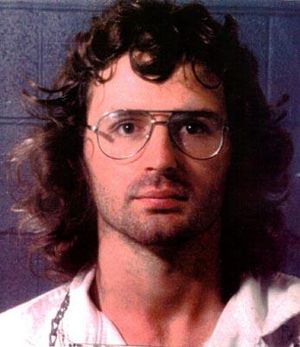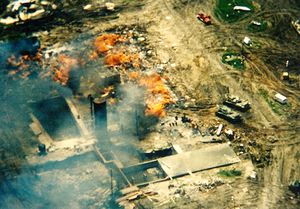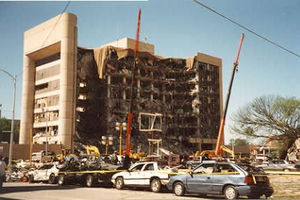Difference between revisions of "What Is the Legacy of the 1993 Waco Tragedy"
| Line 1: | Line 1: | ||
[[File: David_koresh.jpg|300px|thumbnail|left|David Koresh/Vernon Howell]] | [[File: David_koresh.jpg|300px|thumbnail|left|David Koresh/Vernon Howell]] | ||
| − | From February 29, through April 19, 1993 millions of Americans and people from all over the world were glued to their television sets as they watched the violent standoff between an obscure religious sect, known as the Branch Davidians, and the federal government unfold. Most people viewed the events as a curiosity, but some were genuinely worried and afraid that the result would end up similar to what happened months earlier in northern Idaho when a survivalist named Randy Weaver was involved in an armed standoff with federal agents that left his wife and son dead. Unfortunately, they were right – the standoff outside of Waco became one of the most tragic events in recent American history. By the time the standoff was over, four members of the Bureau of Alcohol Tobacco and Firearms (BATF or ATF) were dead along with eighty-two of the Branch Davidians, which included twenty-three children, and scores were injured on both sides. Besides the death toll, which is incredible by peacetime standards, the Waco tragedy sent shockwaves throughout American society that continue to be felt today. | + | __NOTOC__ |
| + | From February 29, through April 19, 1993 millions of Americans and people from all over the world were glued to their television sets as they watched the violent standoff between an obscure religious sect, known as the Branch Davidians, and the federal government unfold. Most people viewed the events as a curiosity, but some were genuinely worried and afraid that the result would end up similar to what happened months earlier in northern Idaho when a survivalist named Randy Weaver was involved in an armed standoff with federal agents that left his wife and son dead. | ||
| + | |||
| + | Unfortunately, they were right – the standoff outside of Waco became one of the most tragic events in recent American history. By the time the standoff was over, four members of the Bureau of Alcohol Tobacco and Firearms (BATF or ATF) were dead along with eighty-two of the Branch Davidians, which included twenty-three children, and scores were injured on both sides. Besides the death toll, which is incredible by peacetime standards, the Waco tragedy sent shockwaves throughout American society that continue to be felt today. | ||
Among the legal impacts of the tragedy were eleven of the surviving Branch Davidians being sent to prison on a variety of charges and two congressional hearings of the events. Perhaps the greatest impact the Waco tragedy had on American society, though, was the lack of faith in the government that it engendered in many and the political polarization it caused on the political landscape as a violent subset of the far-right grew and conspiracy theories on both the far-right and far-left became more prevalent in the American political discourse. | Among the legal impacts of the tragedy were eleven of the surviving Branch Davidians being sent to prison on a variety of charges and two congressional hearings of the events. Perhaps the greatest impact the Waco tragedy had on American society, though, was the lack of faith in the government that it engendered in many and the political polarization it caused on the political landscape as a violent subset of the far-right grew and conspiracy theories on both the far-right and far-left became more prevalent in the American political discourse. | ||
Revision as of 07:44, 25 February 2018
From February 29, through April 19, 1993 millions of Americans and people from all over the world were glued to their television sets as they watched the violent standoff between an obscure religious sect, known as the Branch Davidians, and the federal government unfold. Most people viewed the events as a curiosity, but some were genuinely worried and afraid that the result would end up similar to what happened months earlier in northern Idaho when a survivalist named Randy Weaver was involved in an armed standoff with federal agents that left his wife and son dead.
Unfortunately, they were right – the standoff outside of Waco became one of the most tragic events in recent American history. By the time the standoff was over, four members of the Bureau of Alcohol Tobacco and Firearms (BATF or ATF) were dead along with eighty-two of the Branch Davidians, which included twenty-three children, and scores were injured on both sides. Besides the death toll, which is incredible by peacetime standards, the Waco tragedy sent shockwaves throughout American society that continue to be felt today.
Among the legal impacts of the tragedy were eleven of the surviving Branch Davidians being sent to prison on a variety of charges and two congressional hearings of the events. Perhaps the greatest impact the Waco tragedy had on American society, though, was the lack of faith in the government that it engendered in many and the political polarization it caused on the political landscape as a violent subset of the far-right grew and conspiracy theories on both the far-right and far-left became more prevalent in the American political discourse.
David Koresh and the Branch Davidians
In order to understand how the Waco tragedy affected American society, a brief background examination of David Koresh and the Branch Davidians is warranted. The Branch Davidian sect was the idea of a Hungarian immigrant named Victor Houteff who converted to the Seventh Day Adventist (SDA) church in 1918 and within a few years became one of its major leaders. Believing that his vision of the Bible and the SDA church was the correct one, Houteff took a small group of followers and broke from the main body of the church in 1933, moving to a tract of land outside of Waco, Texas that he christened “Mount Carmel” in reference to the biblical locale in northern Israel.
The breakaway sect slowly grew in size until it asserted its own identity when Houteff rebranded the sect as the “Davidian Seventh-day Adventist” church in 1942. The new name, as well as the name of their church’s location, indicated a more militant tone than what was present in the mainline SDA church. King David was the biblical king who enforced god’s will at sword point and Mount Carmel was the place in the Bible where the prophet Elijah was believed to have fought a battle against followers of the Phoenician god Baal. [1]
David Koresh was born Vernon Howell in 1959 to a mother who left him with her parents and a father he never knew. Anecdotal evidence shows that Howell may have suffered from learning disabilities as a child because he had difficulties reading and in generally in school, but excelled in music, mechanics, and above all – reading scriptures. [2] Howell’s mother was a member of the SDA church, but he was eventually drawn to the Branch Davidians, who he believed followed the scriptures more closely. As he immersed himself in life at Mount Carmel, the ever fractious Davidians split once again in 1984, which led to violence and eventually Howell’s assumption of the church’s leadership.
The split that took place in 1984 was the result of a man named George Roden attempting to assume control of the sect, while Howell and his followers objected. Howell was not the average SDA type, though, as he wore his hair long and often gave his sermons in a t-shirt and jeans. Despite recruiting a number of followers to his faction, Howell was forced to flee Mount Carmel until things took a violent turn in November 3, 1987. It was at that time that Roden dug up the body of a former Davidian and challenged Howell to raise her from the dead. Instead of attempting the impossible feat, Howell lead a group of armed commandos to the Mount Carmel compound to photograph the disinterred remains of the former Davidian. The hope was that they would turn the photographs over to the local authorities who would in turn arrest Roden, thereby giving leadership of the Branch Davidians to Howell. Roden and his followers were waiting and a shootout ensued. Although no one was killed, Howell and his six commandos were charged with attempted murder, which they were eventually acquitted of in April 1988. [3] After the acquittal, Howell was proclaimed the sole leader of the Branch Davidians.
During Howell’s exile from Mount Carmel, he visited the Holy Land in 1985, which is where he claimed that he was brought into heaven and given the secrets of the Seven Seals of the Book of Revelation that played such an integral role in his theology. It was also at that time when he came up with the name David Koresh – David for King David and Koresh for the Persian King Cyrus who released the Jews from their Babylonian captivity in 539 BC – which he legally changed his name to in 1990. [4] Once he was firmly ensconced as the leader of the Branch Davidians, Koresh wasted no time preaching his millennial prophecies of the Seven Seals. Of particular importance to the 1993 events was his interpretation of the Fourth Seal, which he believed allowed him to “kill with the sword.” Concerning this Seal, Koresh once said, “The Bible is a whole book about nothing but killing.” [5] Clearly, Koresh favored the Old Testament god of fire and vengeance. Besides preaching his apocalyptic interpretation of the Bible, Koresh also initiated several changes in the day to day lives of the Branch Davidians. He promoted the idea of polygamy for himself, but he ordered celibacy among all the other male members. By the time of the siege, he fathered seventeen children, two with underage girls and others with women already married. He also lifted the ban on alcohol, although members rarely drank afterwards. [6]
The Investigation
The reason why the Branch Davidians came to the attention of the Bureau of Alcohol Tobacco and Firearms was the combination of a series of newspapers articles about the sect and a random discovery by a postal worker. Mark England and Darlene McCormick, who were local writers for the Waco Tribune-Herald, wrote a seven part series titled “Sinful Messiah,” which focused on some of the more lurid and salacious aspects of life in the compound. The writers interviewed three ATF sources who also happened to be disgruntled former Davidians. One of the sources, Marc Breault, ended up being the key informant who helped get the ATF initiate the investigation of the Davidians. Koresh was never interviewed by England and McCormick. [7] Dovetailing with the “Sinful Messiah” series was the ATF investigation, which officially began in 1992 when a postal worker noticed a number of weapons being mailed to the compound. Although there is nothing inherently illegal about sending guns through the postal service, the ATF believed it warranted an investigation so special agent Robert Rodriguez was tasked with infiltrating the compound. Most of the weapons the agent saw in the compound were legal, but Rodriguez’s reports concluded that the Davidians were manufacturing illegal weapons, which was enough to get a warrant to raid the compound. [8]
The Siege
The ATF seemingly had plenty of time to plan their raid on the Branch Davidians; enough time for them to nickname the operation “Showtime” and to enlist 100 agents and three helicopters for the ill-fated February 28 raid. They believed that by initiating the raid just before ten a.m. they would catch the Davidians off guard and that most of the men would be separated from the women and children. They were tragically wrong. To this day there is still considerable debate concerning which side fired the first shot, but the ensuing firefight resulted in the deaths of four ATF agents and twenty wounded. The Davidians fared a bit better in their casualty count – two of their members were killed and three were wounded. By the afternoon a ceasefire was arranged that allowed the ATF to take their wounded from the scene and several Davidians surrendered and were promptly arrested. But the tragic events of February 28 were only the beginning. [9]
After the initial shootout, the FBI was called to lead the negotiations that most hoped would bring a peaceful resolution and at first it seemed as though that may happen. Expert FBI negotiators seemed to be making headway with Koresh, but as Gary Noesner the lead FBI negotiator for the first half of the siege said, “they had the rug pulled out from under them.” [10] Essentially, the core of the problem was that the FBI did not understand the Davidian’s theology, particularly that they held millennial/apocalyptic interpretations of the Bible and if boxed in they would not be afraid to fulfill those prophecies. [11] Frustrated at what they saw as a lack of progress in the negotiations, the FBI turned the operation over to the Hostage Rescue Team.
The FBI’s Hostage Rescue Team (HRT) is the elite tactical unit employed to confront well-armed suspects ranging from biker gangs to cartels. In early 1993, the HRT was suffering from a bit of a public relations predicament as it was responsible for the death of Randy Weaver’s wife Vicky as she held one their children on August 22, 1992. Despite what many considered a botched mission in Idaho, Dick Rogers, the head of the HRT, believed that the best way to end the standoff with the Branch Davidians was to escalate the tension. After Rogers took control, the FBI employed sensory depravations techniques on the Davidians by blasting loud music late at night and cutting off their power. Eventually, seven Davidians surrendered on March 21, which the FBI elebrated by bulldozing most of the Davidians’ vehicles. [12]
Finally, with armored vehicles and helicopters, the FBI inserted CS gas and pyrotechnics into the compound at six a.m. on April 19. Although the FBI originally denied the use of pyrotechnics in the final assault, evidence emerged in 1999 that they did in fact use the chemical, which in all likelihood led to the fire that consumed the compound. [13] A number of the Davidians actually died of gunshots, including Koresh who was shot in the forehead and contrary to initial reports, all of the bodies of the children were discovered in what the Davidians believed was the fireproof section of their compound. A total of sixty-six Davidians died in the fire that day, including twenty-three children. [14]
A Tragic Legacy
Scholars of the Waco tragedy and the Critical Incident Analysis Group, which is a group of scholars based at the University of Virginia, argue that it is a prime example of a “critical incident.” A critical incident is defined as an act that erodes the public trust in the government and effectively polarizes the population into factions that either oppose or support the state on a particular issue. As evidence, Jayne Docherty pointed to a 1999 Time magazine poll that stated sixty-one percent of those polled believe that government was responsible for the Waco tragedy. [15] Beyond the deep seated damage the Waco tragedy had on the American psyche, it also influenced a number of more immediate events.
Eleven Branch Davidians who left the compound during the siege were charged with a plethora of felonies in federal court ranging from weapons charges to murder. The trial began in early 1994 and although the media led many to believe that the defendants would be convicted on all counts, they were all acquitted of murder. “There was no way we could find them guilty of murder. We felt provocation was pretty evident,” said one anonymous juror. [16] Three were cleared of all charges and seven were found guilty of manslaughter, with five also being convicted of additional weapons charges. In June 1994, Judge Walter Smith exceeded the recommended sentencing guidelines and gave five of the defendants forty years in prison. Judge Smith’s sentencing was later overturned by the United States Supreme Court in 2000 when it ruled that he overstepped his authority during sentencing. [17] All of the surviving Davidians are now free.
There were also two congressional hearings on the siege and standoff, which were summarized in a report by Senator John Danforth. Although the report largely absolved the government of responsibility,[18] a joint congressional report by the House Committee on Government Reform and Oversight and the Committee on the Judiciary concluded that the April 19 assault was “premature.” [19]
Finally, the anger, fear, and confusion that many Americans felt after the Waco tragedy was channeled by the far-right militia movement to increase their numbers in the weeks, months, and years following the event. Although most militia members were not inclined to violence, some were willing to avenge the Branch Davidians any way possible. While the siege was taking place, a young army veteran named Timothy McVeigh was posted behind the police line at Mount Carmel giving out bumper stickers that read, “Is Your Church ATF-Approved?” [20] McVeigh would later go on to bomb the Alfred P. Murrah federal building in Oklahoma City, Oklahoma two years to the day after the Waco siege ended. The FBI and ATF would later change many of their protocols, which has at least been anecdotally successful as their has been no incident of a similar scale since the Waco tragedy. With that said, as Docherty wrote, the tragic events at Waco in 1993 created a massive distrust in the government and a polarization of the population that is obviously apparent today, which is probably the Waco tragedy’s enduring legacy.
References
- ↑ Reavis, Dick. J. The Ashes of Waco: An Investigation. (Syracuse, New York: Syracuse University Press, 1998), p. 59
- ↑ Reavis, p. 26
- ↑ Reavis, pgs. 77-81
- ↑ Reavis, p. 96
- ↑ Reavis, p. 117
- ↑ Reavis, pgs. 111-16
- ↑ Reavis, pgs. 40-43
- ↑ Kerksetter, Todd. “‘That’s Just the American Way’: The Branch Davidian Tragedy and Western Religious History.” Western Historical Quarterly. 35 (2004) pgs. 456-7
- ↑ Kerksetter, p. 458
- ↑ Wright, Stuart A. “A Decade after Waco: Reassessing Crisis Negotiations at Mount Carmel in Light of New Government Disclosures.” Novo Religio: the Journal of Alternative and Emergent Religions. 7 (2003) p. 104
- ↑ Wessinger, Catherine. “Deaths in the Fire at the Branch Davidians’ Mount Carmel: Who Bears Responsibility?” Novo Religio: the Journal of Alternative and Emergent Religions. 13 (2009) p. 31
- ↑ Wright, p. 105
- ↑ Wright, p. 102
- ↑ Wessinger, pgs. 28-32
- ↑ Docherty, Jayne Seminare. “Why Waco Has Not Gone Away: Critical Incidents and Cultural Trauma” Novo Religio: the Journal of Alternative and Emergent Religions. 5 (2001) pgs. 187-189
- ↑ Reavis, p. 278
- ↑ Docherty, p. 191
- ↑ Docherty, p. 192
- ↑ Wright, p. 103
- ↑ Kirksetter, p. 470




